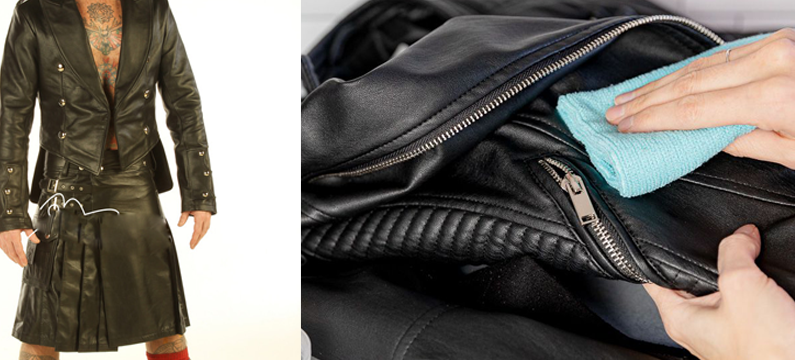Leather kilts are a popular fashion trend that offer both style and comfort. The unique combination of traditional kilt design with the durability and versatility of leather creates a one-of-a-kind look that can last for years. However, without proper care and maintenance, leather kilts can quickly lose their appeal and become damaged beyond repair. That’s why it’s important to learn the proper techniques for cleaning and maintaining your leather kilt. Today, I will try to help you with the proper cleaning and maintenance techniques for your leather kilts.
Choose Which Section Suitable For You!
How do I remove a grease stain from my leather kilt?
To remove grease stains on your leather kilt, you should follow some steps carefully – Start by sprinkling cornstarch or baking soda on the affected area and leave it for a few hours to absorb the grease. After that, wipe away the powder and use a leather cleaner to remove any remaining residue. Make sure to follow the instructions on the leather cleaner carefully and avoid using too much water on your leather kilt.
Can I wear my leather kilt in the rain?
It’s generally not recommended to wear a leather kilt in the rain as leather can be damaged by water. Exposure to water can cause leather to become stiff, lose its natural oils, and even crack over time. If you must wear your leather kilt in the rain, apply a waterproofing spray or leather protectant beforehand to repel water and prevent damage. Allow your kilt to dry naturally at room temperature after exposure to rain, and apply a leather conditioner to restore natural oils and prevent drying. While it’s best to avoid wearing leather in the rain, proper care and precautions can minimize damage.
How do I remove a bad odor from my leather kilt?
If you want to remove bad odors from mens kilts uk, you can use baking soda. First, sprinkle baking soda on the affected area and leave it for a few hours to absorb the odor. Next, wipe away the powder and allow the kilt to hang in a well-ventilated area to air out. If the odor persists, use a leather cleaner that is designed to remove odors. It’s important to note that you should avoid using strong cleaning products or harsh chemicals on your leather kilt, as they can damage the leather.
The Best 4 Tips to Cleaning and Maintains The Men’s Leather Kilts
Preparing Your Leather Kilt for Cleaning
Before cleaning your leather kilt, there are essential steps you need to take to ensure that the cleaning process doesn’t damage your kilt.
Pre-Cleaning Inspection
- Before cleaning your leather kilt, take the time to carefully inspect it for any damages, tears, or stains that require special attention.
- Check the care label provided by the manufacturer for any cleaning instructions or precautions specific to your kilt.
- To prevent any damage or discoloration, it’s always a good idea to test a small and inconspicuous area of your kilt with the cleaning solution before applying it to the rest of the leather. This step ensures that the cleaning solution is safe to use and won’t cause any harm to your kilt
Spot Cleaning and Stain Removal Tips
- Use a soft-bristled brush or a microfiber cloth to remove any dirt or debris from the surface of the leather.
- Blot any wet stains with a dry cloth to remove as much moisture as possible.
- Use a damp cloth to remove dry stains, such as food or makeup stains, but avoid using too much water.
- For stubborn stains, mix equal parts white vinegar and water, then apply the solution to the stain with a soft cloth. Let it sit for a few minutes, then wipe it off with a clean, damp cloth.
Choosing the Right Cleaning Products
- Avoid using harsh chemicals or abrasive cleaning agents that can damage the leather.
- Use a cleaner specifically designed for leather or a mild soap and water solution.
- Read the label of the cleaning product carefully before using it to ensure that it’s safe for use on leather.
Following these pre-cleaning steps will help you clean your leather kilt without causing any damage or discoloration to the leather.
Cleaning Your Leather Kilt
Regular cleaning is essential to maintain the appearance and lifespan of your men’s leather kilt. Here are some step-by-step instructions for cleaning your kilt:
Step-by-Step Cleaning Instructions
- Start by removing any dirt or debris from the surface of the leather with a soft-bristled brush or a microfiber cloth.
- Prepare a cleaning solution by mixing mild soap and warm water in a small bowl.
- Dip a soft cloth into the cleaning solution and wring out the excess water.
- Gently wipe the leather surface with the damp cloth, being careful not to saturate the leather with water.
- Rinse the cloth with clean water and wipe the leather surface again to remove any soap residue.
- Dry the leather surface with a clean, dry cloth, then hang the kilt to air dry for a few hours before wearing it again.
How Often to Clean Your Leather Kilt
- It’s recommended that you clean your leather kilt after every 5-6 wears to prevent dirt and sweat buildup.
- However, if your kilt is exposed to rain or spills, you should clean it as soon as possible to prevent staining or water damage.
Drying and Storing Your Kilt Properly
- Never use a dryer or any heat source to dry your leather kilt, as it can cause the leather to crack or shrink.
- Hang your kilt on a wooden hanger or fold it neatly and store it in a dry, cool place away from direct sunlight.
- Avoid storing your kilt in a plastic bag, as it can trap moisture and cause mildew to develop.
If you follow these cleaning instructions and storage tips, It will help you maintain the quality and appearance of your men’s leather kilt for years to come.
Maintaining Your Men’s Leather Kilt
Aside from regular cleaning, proper maintenance can help prevent damage and wear to your men’s leather kilt. Here are some tips to help you maintain your kilts.
Tips for Preventing Damage and Wear
- Avoid exposing your leather kilt to direct sunlight or heat, which can cause the leather to dry out and fade.
- Avoid wearing your kilt in extreme weather conditions, such as heavy rain or snow.
- Always remove your kilt before engaging in physical activities or using harsh chemicals, as they can cause damage to the leather.
- Apply a leather conditioner every 3-6 months to keep the leather moisturized and supple.
Repairing Minor Damages
- If you notice minor damages, such as scratches or scuffs, you can repair them yourself using a leather repair kit.
- Simply apply the repair solution to the affected area and follow the instructions on the kit.
When to Seek Professional Help
- If your leather kilt is severely damaged or requires major repairs, it’s best to seek professional help.
- Look for a leather repair specialist who has experience working with leather kilts to ensure that the repairs are done correctly.
- Don’t attempt to repair major damages yourself, as it can cause further damage to the leather.
By following these maintenance tips, you can help prolong the lifespan of your men’s leather kilt and keep it looking its best for years to come.
Understanding Men’s Leather Kilts
From the specialized, I think it’s essential to have an understanding of the different types of leather used in making kilts and the various styles available. Let’s know the history of kilts and more details of types of leather and lilts.
Types of Leather Used in Making Kilts
- Cowhide leather: This is the most commonly used leather in kilt making. It’s durable and has a textured surface that provides a rugged look.
- Lambskin leather: This leather is soft and supple, making it comfortable to wear. It’s also lightweight and flexible, making it a popular choice for modern styles.
- Goatskin leather: Goatskin leather is durable and has a unique texture, making it ideal for traditional kilts.
Common Styles of Men’s Leather Kilts
- Traditional Tartan Kilt: This style features a leather front apron with a tartan pleated back.
- Utility Kilt: This style has multiple pockets, making it suitable for practical use.
- Contemporary Kilt: This style incorporates modern fashion elements such as zippers and studs.
- Hybrid Kilt: This style combines traditional tartan kilt design with modern features.
Understanding the different types of leather and kilt styles available Also could help you choose the right cleaning and maintenance techniques for your specific kilt.
What Are Some Maintenance Tips for Women’s Kilts?
When it comes to tips for choosing ladies kilt skirt, there are a few maintenance tips to keep in mind. Always follow the care instructions on the label, and consider dry cleaning for more delicate materials. Additionally, store your kilt properly to maintain its shape and condition for years to come.
Frequently Asked Questions
Question 1: Can I wash my leather kilt in a washing machine?
Answer: No, it’s not recommended to wash a leather kilt in a washing machine, as the agitation and moisture can damage the leather. Instead, hand wash your kilt using mild soap and warm water.
Question 2: How do I prevent my leather kilt from drying out?
Answer: To prevent your leather kilt from drying out, apply a leather conditioner every 3-6 months to keep the leather moisturized and supple. Additionally, avoid exposing your kilt to direct sunlight or heat, which can cause the leather to dry out.
Expert Opinion
Caring for your leather kilts is essential to ensure that it lasts for years to come. By following proper cleaning and maintenance techniques, you can prevent damage and wear to your kilt and keep it looking its best. You should spend time and money to care your leathers apparels in the right way because investing in the proper care and maintenance of leather kilts is crucial to preserving its appearance and extending its lifespan.



